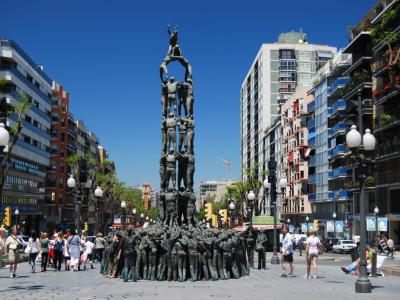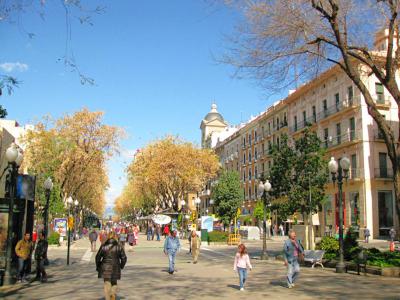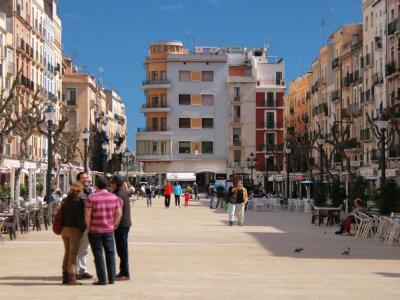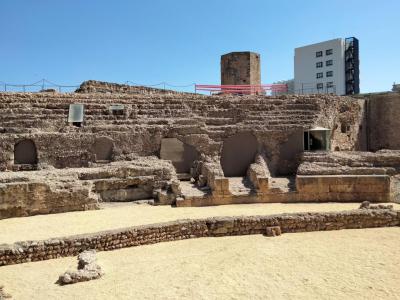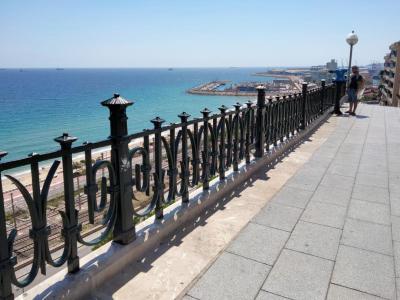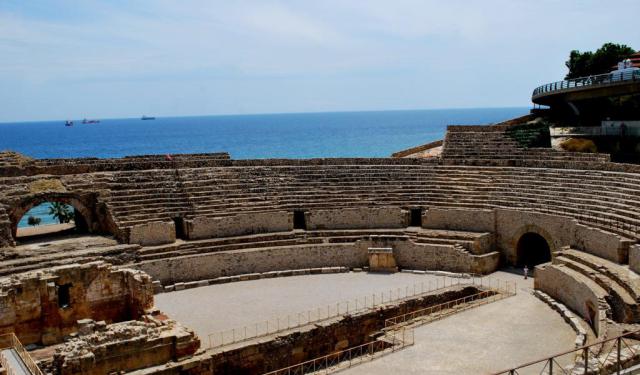Tarragona Introduction Walking Tour (Self Guided), Tarragona
Nestled in the southern part of Catalonia, Spain, Tarragona is a coastal city boasting an abundance of ancient Roman ruins, rolling mountains, and magnificent beaches.
Shrouded in myth and mystery, Tarragona carries a name whose origins remain debated-linked to figures like Tarraho or Tearcon the Ethiopian, a seventh-century BC pharaoh. Its true founding date is also obscured in time.
Situated strategically along the northeastern Iberian coast, the town emerged as a fortified Roman colony during the Republic, fortified against Carthaginian threats. Named Colonia Iulia Urbs Triumphalis Tarraco, it rose to prominence as the capital of the Roman province Hispania Citerior and later Hispania Tarraconensis.
Over the centuries, Tarragona witnessed the ebb and flow of dominion-from Vandals and Visigoths to the Umayyad Caliphate, then incorporation into the County of Barcelona and Principality of Tarragona, before aligning with the Crown of Aragon and, eventually, the Spanish Empire.
The city endured tumultuous sieges during conflicts like the Peninsular War of the 1810s, where it alternated between French and Anglo-Spanish control, and the Spanish Civil War, culminating in its capture by Franco's Nationalist forces in 1939. These historic upheavals have woven a complex tapestry of resilience and endurance into Tarragona's cultural fabric, leaving an indelible mark on its storied past.
The Monument to the Castellers stands tall as a tribute to the centuries-old tradition of human tower building, a cultural phenomenon deeply rooted in Catalan culture.
Strolling along The New Boulevard (La Rambla Nova), visitors are enveloped in a lively atmosphere, where street performers entertain and sidewalk cafes beckon for leisurely indulgence.
Art enthusiasts will find solace in the Silk Square Mural, a captivating wall painting depicting scenes from Tarragona's history, while the Tarragona Maquette offers a miniature glimpse into the city's illustrious past.
Religious fervor finds expression in the Metropolitan Primatial Basilica Cathedral of Tarragona, a majestic temple dating back to the 12th century.
Steeped in antiquity, Tarragona's Roman legacy looms large, with the well-preserved ruins of the Roman Circus and Amphitheatre. Perched on the edge of sheer cliffs, the Mediterranean Balcony offers panoramic vistas of the azure Mediterranean Sea, inviting contemplation and awe.
As you traverse the streets of Tarragona, its timeless beauty may easily ignite your wanderlust. Indeed, this city promises an unforgettable journey through the annals of history and the embrace of Mediterranean warmth. So, embark on this adventure of discovery now and let Tarragona weave its spell upon you, one captivating moment at a time!
Shrouded in myth and mystery, Tarragona carries a name whose origins remain debated-linked to figures like Tarraho or Tearcon the Ethiopian, a seventh-century BC pharaoh. Its true founding date is also obscured in time.
Situated strategically along the northeastern Iberian coast, the town emerged as a fortified Roman colony during the Republic, fortified against Carthaginian threats. Named Colonia Iulia Urbs Triumphalis Tarraco, it rose to prominence as the capital of the Roman province Hispania Citerior and later Hispania Tarraconensis.
Over the centuries, Tarragona witnessed the ebb and flow of dominion-from Vandals and Visigoths to the Umayyad Caliphate, then incorporation into the County of Barcelona and Principality of Tarragona, before aligning with the Crown of Aragon and, eventually, the Spanish Empire.
The city endured tumultuous sieges during conflicts like the Peninsular War of the 1810s, where it alternated between French and Anglo-Spanish control, and the Spanish Civil War, culminating in its capture by Franco's Nationalist forces in 1939. These historic upheavals have woven a complex tapestry of resilience and endurance into Tarragona's cultural fabric, leaving an indelible mark on its storied past.
The Monument to the Castellers stands tall as a tribute to the centuries-old tradition of human tower building, a cultural phenomenon deeply rooted in Catalan culture.
Strolling along The New Boulevard (La Rambla Nova), visitors are enveloped in a lively atmosphere, where street performers entertain and sidewalk cafes beckon for leisurely indulgence.
Art enthusiasts will find solace in the Silk Square Mural, a captivating wall painting depicting scenes from Tarragona's history, while the Tarragona Maquette offers a miniature glimpse into the city's illustrious past.
Religious fervor finds expression in the Metropolitan Primatial Basilica Cathedral of Tarragona, a majestic temple dating back to the 12th century.
Steeped in antiquity, Tarragona's Roman legacy looms large, with the well-preserved ruins of the Roman Circus and Amphitheatre. Perched on the edge of sheer cliffs, the Mediterranean Balcony offers panoramic vistas of the azure Mediterranean Sea, inviting contemplation and awe.
As you traverse the streets of Tarragona, its timeless beauty may easily ignite your wanderlust. Indeed, this city promises an unforgettable journey through the annals of history and the embrace of Mediterranean warmth. So, embark on this adventure of discovery now and let Tarragona weave its spell upon you, one captivating moment at a time!
How it works: Download the app "GPSmyCity: Walks in 1K+ Cities" from Apple App Store or Google Play Store to your mobile phone or tablet. The app turns your mobile device into a personal tour guide and its built-in GPS navigation functions guide you from one tour stop to next. The app works offline, so no data plan is needed when traveling abroad.
Tarragona Introduction Walking Tour Map
Guide Name: Tarragona Introduction Walking Tour
Guide Location: Spain » Tarragona (See other walking tours in Tarragona)
Guide Type: Self-guided Walking Tour (Sightseeing)
# of Attractions: 10
Tour Duration: 2 Hour(s)
Travel Distance: 2.7 Km or 1.7 Miles
Author: DanaOffice
Sight(s) Featured in This Guide:
Guide Location: Spain » Tarragona (See other walking tours in Tarragona)
Guide Type: Self-guided Walking Tour (Sightseeing)
# of Attractions: 10
Tour Duration: 2 Hour(s)
Travel Distance: 2.7 Km or 1.7 Miles
Author: DanaOffice
Sight(s) Featured in This Guide:
- Monumento als Castellers (Monument to the Castellers)
- Mercado Central (Central Market)
- La Rambla Nova (The New Boulevard)
- Placa de la Font (Fountain Square)
- Placa dels Sedassos Mural (The Silk Square Mural)
- Maqueta Tarraco (Tarragona Maquette)
- Catedral Basilica Metropolitana Primada de Tarragona (Metropolitan Primatial Basilica Cathedral of Tarragona)
- Circ Roma (Roman circus)
- Anfiteatro (Amphitheatre)
- Balcó del Mediterrani (Mediterranean Balcony)
1) Monumento als Castellers (Monument to the Castellers)
The Monument to the Castellers (the human towers) is a sculpture created by Catalan sculptor Francesc Anglès i Garcia. Inaugurated on May 29, 1999, this bronze sculpture stands eleven meters tall and weighs twelve tons.
The artwork captures the moment when the castell is being loaded, and the crowning is about to take place. The 4 by 8 castell is crafted to life size and features a total of 222 meticulously detailed figures. Within the structure, 219 figures are integrated, including notable faces like Pau Casals, Pablo Picasso, Antoni Gaudí, Joan Miró, Joan Antoni Samaranch, and various characters from Santa Coloma de Queralt. These figures are positioned on the pine tree, the trunk, and the knob above, each contributing to the intricate representation.
Outside the castell, a group of three musicians, consisting of two crooners and a timpanist, stands on one side, while the band leader, directing the castle, is on the other. The plaster model used for creating the bronze casting mold was initially exhibited in front of the Castle of the Counts of Santa Coloma de Queralt, underscoring the artist's connection with this municipality.
The artwork captures the moment when the castell is being loaded, and the crowning is about to take place. The 4 by 8 castell is crafted to life size and features a total of 222 meticulously detailed figures. Within the structure, 219 figures are integrated, including notable faces like Pau Casals, Pablo Picasso, Antoni Gaudí, Joan Miró, Joan Antoni Samaranch, and various characters from Santa Coloma de Queralt. These figures are positioned on the pine tree, the trunk, and the knob above, each contributing to the intricate representation.
Outside the castell, a group of three musicians, consisting of two crooners and a timpanist, stands on one side, while the band leader, directing the castle, is on the other. The plaster model used for creating the bronze casting mold was initially exhibited in front of the Castle of the Counts of Santa Coloma de Queralt, underscoring the artist's connection with this municipality.
2) Mercado Central (Central Market)
The Central Market of Tarragona, inaugurated on December 19, 1915, holds historical significance and reflects a unique modernist character in its architecture.
The market structure comprises three longitudinal naves and a transversal nave, creating a symmetrical division of the floor. Fiber cement roofs are supported by pointed arch metal structures and columns adorned with modernist capitals. The exterior showcases two main facades featuring three semicircular arches each-a large central one corresponding to the central nave and two lateral ones. These architectural elements contribute to the strong modernist aesthetic of the building.
The establishment of the Central Market aimed to address the issue of scattered markets throughout the city. The offers an array of fresh produce such as fish, meat, fruits, vegetables, cheeses, olives, nuts, and more. Additionally, there are a couple of spots where patrons can relish a glass of wine, coffee, and tapas. Meanwhile, the basement houses a contemporary supermarket from a well-known chain.
Don't miss the captivating clock show. At both 12 noon and 6 pm daily, seven figures representing the popular Santa Tecla procession come to life, dancing to the lively beats of the Amparito Roca pasodoble. Beyond being a hub for fresh and seasonal products, the Central Market serves as the pulsating heart of the city, where the essence of Tarragona comes to life.
The market structure comprises three longitudinal naves and a transversal nave, creating a symmetrical division of the floor. Fiber cement roofs are supported by pointed arch metal structures and columns adorned with modernist capitals. The exterior showcases two main facades featuring three semicircular arches each-a large central one corresponding to the central nave and two lateral ones. These architectural elements contribute to the strong modernist aesthetic of the building.
The establishment of the Central Market aimed to address the issue of scattered markets throughout the city. The offers an array of fresh produce such as fish, meat, fruits, vegetables, cheeses, olives, nuts, and more. Additionally, there are a couple of spots where patrons can relish a glass of wine, coffee, and tapas. Meanwhile, the basement houses a contemporary supermarket from a well-known chain.
Don't miss the captivating clock show. At both 12 noon and 6 pm daily, seven figures representing the popular Santa Tecla procession come to life, dancing to the lively beats of the Amparito Roca pasodoble. Beyond being a hub for fresh and seasonal products, the Central Market serves as the pulsating heart of the city, where the essence of Tarragona comes to life.
3) La Rambla Nova (The New Boulevard)
The New Boulevard, stands as a symbolic divider between the Upper Part, encompassing the Old Town, and the lower area of the city. The history of the New Boulevard dates back to 1854. This expansive avenue, measuring 45 meters in width, boasts a grand central promenade flanked by two roads on either side. Stretching for a kilometer, it serves as a vital link between the Francolí River and the Mediterranean Sea, defining the cityscape with its significance.
A stroll along this iconic avenue unveils a diverse array of architectural styles, exemplified by prominent buildings like the modernist Casa Salas, the noucentisme-inspired Teresianas school, and the neoclassical Bank of Spain building. The central promenade serves as a vibrant space where residents and tourists converge, meandering, taking respite on numerous benches, and admiring various sculptural works adorning the avenue.
Noteworthy sculptures along the New Boulevard include the monument to the human towers, the Centennial fountain, the statue of Roger de Llúria, and the distinctive seated statue of printer Josep Virgili. The avenue pulsates with life, offering a multitude of services such as kiosks, diverse shops, and hotels like the Ciutat de Tarragona and the SB Express.
Embraced by the Tarragona community, La Rambla Nova holds cultural significance, as reflected in the local expression "anar a Toca Ferro" (go to touch iron), which is associated with leisurely walks along the avenue, leading to the Balcony of the Mediterranean. This vantage point provides a tranquil space for residents and visitors to enjoy the scenic views of the Mediterranean Sea, contributing to the charm and allure of La Rambla Nova in Tarragona.
A stroll along this iconic avenue unveils a diverse array of architectural styles, exemplified by prominent buildings like the modernist Casa Salas, the noucentisme-inspired Teresianas school, and the neoclassical Bank of Spain building. The central promenade serves as a vibrant space where residents and tourists converge, meandering, taking respite on numerous benches, and admiring various sculptural works adorning the avenue.
Noteworthy sculptures along the New Boulevard include the monument to the human towers, the Centennial fountain, the statue of Roger de Llúria, and the distinctive seated statue of printer Josep Virgili. The avenue pulsates with life, offering a multitude of services such as kiosks, diverse shops, and hotels like the Ciutat de Tarragona and the SB Express.
Embraced by the Tarragona community, La Rambla Nova holds cultural significance, as reflected in the local expression "anar a Toca Ferro" (go to touch iron), which is associated with leisurely walks along the avenue, leading to the Balcony of the Mediterranean. This vantage point provides a tranquil space for residents and visitors to enjoy the scenic views of the Mediterranean Sea, contributing to the charm and allure of La Rambla Nova in Tarragona.
4) Placa de la Font (Fountain Square)
The Fountain Square, situated at the heart of the city, occupies a quarter of the ancient Roman circus arena. Below the square lies an underground parking lot, adding modern convenience to this historic site. Today, the square has become a vibrant hub for the city's nightlife. It is lined with bars and restaurants, and has a great atmosphere.
In 1827, a monumental fountain, crafted by master Pere Anton Verderol and sculptor Vicenç Roig, adorned the square until its disappearance in the mid-19th century. The area underwent a redesign in 1839 when architect Josep Oriol presented a project for the square's transformation. Multiple municipal architects contributed to the design, with notable elements like the streetlights envisioned by architect Ramon Salas i Ricomá in 1889.
The current cast iron fountain, symbolically referencing the square's name, was inaugurated on April 19, 1979, following the last plenary session of the council transitioning into the new democratic era. Notably, during the nineties, when the parking lot was constructed, some medieval well remnants were unfortunately destroyed. The fountain, representing the essence of the square, was temporarily removed and later reinstated towards the central part of the square. Visitors to the square can catch glimpses of Roman remains that have been preserved and are on display to the public.
In 1827, a monumental fountain, crafted by master Pere Anton Verderol and sculptor Vicenç Roig, adorned the square until its disappearance in the mid-19th century. The area underwent a redesign in 1839 when architect Josep Oriol presented a project for the square's transformation. Multiple municipal architects contributed to the design, with notable elements like the streetlights envisioned by architect Ramon Salas i Ricomá in 1889.
The current cast iron fountain, symbolically referencing the square's name, was inaugurated on April 19, 1979, following the last plenary session of the council transitioning into the new democratic era. Notably, during the nineties, when the parking lot was constructed, some medieval well remnants were unfortunately destroyed. The fountain, representing the essence of the square, was temporarily removed and later reinstated towards the central part of the square. Visitors to the square can catch glimpses of Roman remains that have been preserved and are on display to the public.
5) Placa dels Sedassos Mural (The Silk Square Mural)
The Silk Square, adorned with a captivating mural, showcases the art of "trompe l'oeil," a technique designed to deceive the eye. Crafted by painter and muralist Carles Arola in 1995, this mural transforms the facade of a building into a visually stunning masterpiece.
The mural depicts a barren wall brought to life with the illusion of traditional 19th-century balconies. Quirky characters occupy these balconies, engaging with passersby. The scene is further enhanced by flowers, potted plants, and creeping vines, creating a vibrant and dynamic tableau. Notably, on the lower level, a horse playfully peeks out from behind a wooden door, adding an element of surprise.
This unique mural not only captivates observers with its artistic brilliance but also provides a glimpse into the city's distinct character. As you explore the nearby ancient ruins, the mural serves as a testament to the city's diverse and creative spirit.
The mural depicts a barren wall brought to life with the illusion of traditional 19th-century balconies. Quirky characters occupy these balconies, engaging with passersby. The scene is further enhanced by flowers, potted plants, and creeping vines, creating a vibrant and dynamic tableau. Notably, on the lower level, a horse playfully peeks out from behind a wooden door, adding an element of surprise.
This unique mural not only captivates observers with its artistic brilliance but also provides a glimpse into the city's distinct character. As you explore the nearby ancient ruins, the mural serves as a testament to the city's diverse and creative spirit.
6) Maqueta Tarraco (Tarragona Maquette)
The Tarragona Maquette, displayed in the Old Courthouse at Pallol Square, offers a captivating glimpse into the ancient city of Tarraco during its zenith in the 2nd century AD. This intricate model, showcasing Tarragona at 1:500 scale over an expansive 18m², provides a detailed panorama of the city's grandeur during a period of significant expansion. Created by the Museum of History of Tarragona, this model fills a crucial gap in the interpretation of the Roman city.
Crafted by model maker Elies Torres, the maquette frames Tarragona between the port, the ager (surrounding fields), and the Francolí River. Notably, it stands as the second-largest model of the Roman world in Europe, surpassed only by Rome itself. The ambitious project required 8000 hours of dedicated work, including meticulous topographical studies, ensuring accuracy and authenticity in portraying Tarraco's historical splendor. A visit to the Maqueta Tarraco offers a unique journey back in time to witness the architectural and cultural richness of this UNESCO World Heritage Site.
Crafted by model maker Elies Torres, the maquette frames Tarragona between the port, the ager (surrounding fields), and the Francolí River. Notably, it stands as the second-largest model of the Roman world in Europe, surpassed only by Rome itself. The ambitious project required 8000 hours of dedicated work, including meticulous topographical studies, ensuring accuracy and authenticity in portraying Tarraco's historical splendor. A visit to the Maqueta Tarraco offers a unique journey back in time to witness the architectural and cultural richness of this UNESCO World Heritage Site.
7) Catedral Basilica Metropolitana Primada de Tarragona (Metropolitan Primatial Basilica Cathedral of Tarragona) (must see)
The Metropolitan Primatial Basilica Cathedral of Tarragona, commonly known as Tarragona Cathedral, stands as a magnificent testament to centuries of history and religious significance in the heart of Tarragona.
Construction of the cathedral began in the 12th century on the site of a former Roman temple, and its evolution mirrors the diverse influences of the times. The cathedral exhibits a harmonious blend of Romanesque, Gothic, and Baroque styles, showcasing the intricate craftsmanship and artistic expression of the architects and builders involved over the centuries.
The exterior of Tarragona Cathedral is a visual journey through time, featuring a Romanesque cloister, a Gothic façade adorned with delicate sculptures, and a majestic rose window that adds a touch of splendor. The imposing bell tower, known as the "Campanar de la Catedral," offers panoramic views of Tarragona and the surrounding landscapes.
Upon entering the cathedral, visitors are greeted by a sanctuary of religious art and historical artifacts. The interior boasts impressive Gothic and Baroque chapels, intricately carved choir stalls, and a revered main altar. The atmospheric ambiance within the cathedral is further enhanced by the play of light and shadow, casting a serene atmosphere conducive to contemplation.
Tarragona Cathedral also serves as the final resting place for notable figures, adding a layer of historical significance. The cathedral's religious importance is underscored by its status as the seat of the Archdiocese of Tarragona, making it a place of spiritual leadership and worship.
Construction of the cathedral began in the 12th century on the site of a former Roman temple, and its evolution mirrors the diverse influences of the times. The cathedral exhibits a harmonious blend of Romanesque, Gothic, and Baroque styles, showcasing the intricate craftsmanship and artistic expression of the architects and builders involved over the centuries.
The exterior of Tarragona Cathedral is a visual journey through time, featuring a Romanesque cloister, a Gothic façade adorned with delicate sculptures, and a majestic rose window that adds a touch of splendor. The imposing bell tower, known as the "Campanar de la Catedral," offers panoramic views of Tarragona and the surrounding landscapes.
Upon entering the cathedral, visitors are greeted by a sanctuary of religious art and historical artifacts. The interior boasts impressive Gothic and Baroque chapels, intricately carved choir stalls, and a revered main altar. The atmospheric ambiance within the cathedral is further enhanced by the play of light and shadow, casting a serene atmosphere conducive to contemplation.
Tarragona Cathedral also serves as the final resting place for notable figures, adding a layer of historical significance. The cathedral's religious importance is underscored by its status as the seat of the Archdiocese of Tarragona, making it a place of spiritual leadership and worship.
8) Circ Roma (Roman circus)
The Roman Circus stands as a captivating archaeological site that transports visitors back in time to the grandeur of ancient Roman entertainment and civic life. This well-preserved structure is a testament to the engineering prowess and cultural sophistication of the Roman Empire, showcasing the significance of Tarraco, the ancient Roman name for Tarragona, as a regional hub.
Constructed in the 1st century AD, the Roman Circus was primarily used for chariot races, a popular and thrilling spectacle in Roman society. The layout of the circus follows a traditional Roman design, featuring an elongated racetrack with semicircular ends, known as the spina, and tiered seating for spectators. The arena could accommodate thousands of enthusiastic onlookers who gathered to witness the exhilarating races and other public events.
The remnants of the Roman Circus offer a vivid glimpse into the scale and structure of the original circus. The elongated track, marked by well-preserved barriers and central spina, provides insight into the logistics of chariot races and the grandeur of the events held here. The spectator stands, arranged in a horseshoe shape, showcase the Romans' architectural ingenuity in optimizing sightlines for the audience.
The Roman Circus also served broader civic and social functions beyond chariot races. It was a multifunctional space used for public gatherings, religious ceremonies, and other communal events. The circus played a central role in the social and cultural life of Tarraco, reflecting the Roman emphasis on public entertainment and communal bonding.
Today, the site is carefully preserved, allowing modern visitors to walk through the remnants of the Roman Circus. Interpretative displays and informational signage contribute to a richer understanding of the historical context and significance of this archaeological gem.
Constructed in the 1st century AD, the Roman Circus was primarily used for chariot races, a popular and thrilling spectacle in Roman society. The layout of the circus follows a traditional Roman design, featuring an elongated racetrack with semicircular ends, known as the spina, and tiered seating for spectators. The arena could accommodate thousands of enthusiastic onlookers who gathered to witness the exhilarating races and other public events.
The remnants of the Roman Circus offer a vivid glimpse into the scale and structure of the original circus. The elongated track, marked by well-preserved barriers and central spina, provides insight into the logistics of chariot races and the grandeur of the events held here. The spectator stands, arranged in a horseshoe shape, showcase the Romans' architectural ingenuity in optimizing sightlines for the audience.
The Roman Circus also served broader civic and social functions beyond chariot races. It was a multifunctional space used for public gatherings, religious ceremonies, and other communal events. The circus played a central role in the social and cultural life of Tarraco, reflecting the Roman emphasis on public entertainment and communal bonding.
Today, the site is carefully preserved, allowing modern visitors to walk through the remnants of the Roman Circus. Interpretative displays and informational signage contribute to a richer understanding of the historical context and significance of this archaeological gem.
9) Anfiteatro (Amphitheatre) (must see)
Situated within the archaeological ensemble of Tarraco, a UNESCO World Heritage site, the Amphitheatre showcases the rich history and cultural significance of the region during the Roman era.
Constructed in the 2nd century AD, the Tarragona Amphitheatre was a pivotal center for gladiatorial contests, animal hunts, and other public spectacles that played a crucial role in Roman social and cultural life. The amphitheatre's strategic location, overlooking the Mediterranean Sea, further enhanced its appeal as a venue for grand events.
Key features of the Tarragona Amphitheatre include its elliptical shape, well-preserved seating tiers, and a network of tunnels and chambers beneath the arena floor. The elliptical design, a hallmark of Roman amphitheatres, allowed for optimal visibility and acoustics, ensuring that the audience could witness the events with maximum impact.
The seating tiers, arranged in a series of concentric rings, could accommodate thousands of spectators, emphasizing the amphitheatre's role as a communal space for entertainment and social gatherings. The tiered seating also reflected the hierarchical structure of Roman society, with different sections designated for various social classes.
Beneath the arena floor, a complex system of tunnels and chambers served practical purposes, facilitating the movement of gladiators, animals, and stage props during performances. These subterranean spaces provided a backstage area for the elaborate spectacles that unfolded above ground.
Today, the Tarragona Amphitheatre stands as a well-preserved archaeological site, inviting visitors to explore its ancient grandeur. The site offers panoramic views of the surrounding landscape. Interpretative displays and guided tours contribute to a deeper understanding of the historical context and significance of this iconic structure.
Constructed in the 2nd century AD, the Tarragona Amphitheatre was a pivotal center for gladiatorial contests, animal hunts, and other public spectacles that played a crucial role in Roman social and cultural life. The amphitheatre's strategic location, overlooking the Mediterranean Sea, further enhanced its appeal as a venue for grand events.
Key features of the Tarragona Amphitheatre include its elliptical shape, well-preserved seating tiers, and a network of tunnels and chambers beneath the arena floor. The elliptical design, a hallmark of Roman amphitheatres, allowed for optimal visibility and acoustics, ensuring that the audience could witness the events with maximum impact.
The seating tiers, arranged in a series of concentric rings, could accommodate thousands of spectators, emphasizing the amphitheatre's role as a communal space for entertainment and social gatherings. The tiered seating also reflected the hierarchical structure of Roman society, with different sections designated for various social classes.
Beneath the arena floor, a complex system of tunnels and chambers served practical purposes, facilitating the movement of gladiators, animals, and stage props during performances. These subterranean spaces provided a backstage area for the elaborate spectacles that unfolded above ground.
Today, the Tarragona Amphitheatre stands as a well-preserved archaeological site, inviting visitors to explore its ancient grandeur. The site offers panoramic views of the surrounding landscape. Interpretative displays and guided tours contribute to a deeper understanding of the historical context and significance of this iconic structure.
10) Balcó del Mediterrani (Mediterranean Balcony) (must see)
Constructed in the early 20th century, the Mediterranean Balcony is situated atop the ancient Roman walls that once fortified the city. Its strategic location offers panoramic views of the Mediterranean, providing locals and visitors alike with a stunning perspective on the vast expanse of the sea.
The centerpiece of the Mediterranean Balcony is the ornate white marble railing adorned with intricate sculptures, including allegorical figures and maritime motifs. The craftsmanship and detailing on the railing contribute to the overall aesthetic appeal of the structure. The balustrade also features a prominent statue of Roger de Llúria, a medieval Catalan military commander and admiral, adding a historical touch to the panoramic lookout.
Adjacent to the Mediterranean Balcony, there is a staircase that descends towards the sea, providing access to the beach below. This integration of the architectural landmark with the natural surroundings enhances its significance as a place of connection between the city and the maritime environment.
In the evenings, the Balcó del Mediterrani takes on a romantic aura as the sun sets over the Mediterranean, casting warm hues across the sky and water. This magical moment adds to the allure of the Mediterranean Balcony, making it a captivating destination for locals and tourists seeking a serene and visually stunning experience in Tarragona.
The centerpiece of the Mediterranean Balcony is the ornate white marble railing adorned with intricate sculptures, including allegorical figures and maritime motifs. The craftsmanship and detailing on the railing contribute to the overall aesthetic appeal of the structure. The balustrade also features a prominent statue of Roger de Llúria, a medieval Catalan military commander and admiral, adding a historical touch to the panoramic lookout.
Adjacent to the Mediterranean Balcony, there is a staircase that descends towards the sea, providing access to the beach below. This integration of the architectural landmark with the natural surroundings enhances its significance as a place of connection between the city and the maritime environment.
In the evenings, the Balcó del Mediterrani takes on a romantic aura as the sun sets over the Mediterranean, casting warm hues across the sky and water. This magical moment adds to the allure of the Mediterranean Balcony, making it a captivating destination for locals and tourists seeking a serene and visually stunning experience in Tarragona.
Walking Tours in Tarragona, Spain
Create Your Own Walk in Tarragona
Creating your own self-guided walk in Tarragona is easy and fun. Choose the city attractions that you want to see and a walk route map will be created just for you. You can even set your hotel as the start point of the walk.
Roman Ruins Walking Tour
The city of Tarraco, the capital of the Hispania Tarraconensis province, held significant prominence within the vast Roman Empire. The remnants of those days, concentrated in the heart of Tarragona, are the pivotal historical sites that contribute to its UNESCO World Heritage status.
Indeed, the city's acclaim largely stems from its Roman ruins, notably the 2nd-century AD Roman... view more
Tour Duration: 2 Hour(s)
Travel Distance: 2.9 Km or 1.8 Miles
Indeed, the city's acclaim largely stems from its Roman ruins, notably the 2nd-century AD Roman... view more
Tour Duration: 2 Hour(s)
Travel Distance: 2.9 Km or 1.8 Miles
The Most Popular Cities
/ view all



